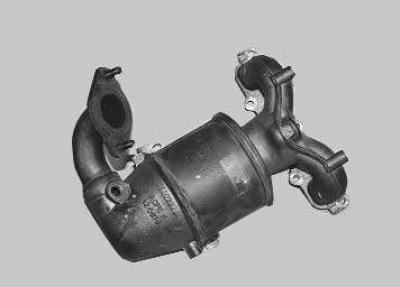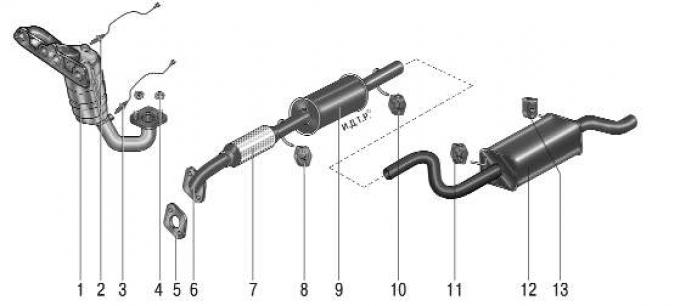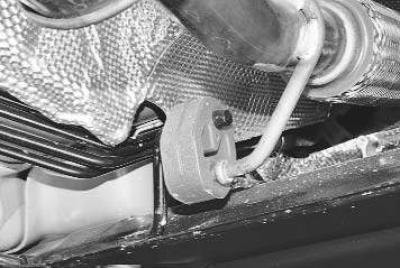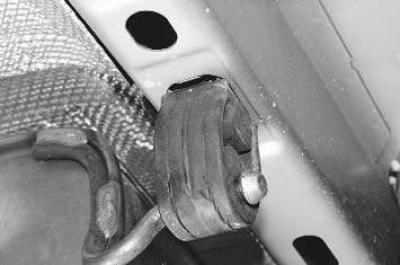
Additional and main mufflers with bellows are made as a single element.

Pic. 5.13. Exhaust system: 1 – control oxygen concentration sensor; 2 – collector; 3 – diagnostic oxygen concentration sensor; 4 - nuts; 5 - gasket; 6 - receiving pipe; 7 - bellows; 8, 10, 11, 13 - suspension cushions of the exhaust gas system; 9 – additional muffler; 12 - main muffler
Note. For Ford Fusion vehicles with a 1.4 liter engine, an additional muffler is not installed.
Two oxygen concentration sensors are installed on the collector: diagnostic and main (manager).
A sealing metal-reinforced gasket is installed between the cylinder head and the exhaust manifold flange, which is common with the intake pipe.
The exhaust pipe of the additional muffler is connected through a metal-reinforced gasket to the collector.
To reduce the transmission of vibration from the power unit to the exhaust system and the body, a vibration-compensating corrugated bellows in a metal braid is mounted in the exhaust pipe of the additional silencer.
The collector is fixed with nuts on the studs of the cylinder head and is additionally fixed with a bracket on the engine.

The elements of the exhaust system are suspended from the body on three rubber cushions of the same shape, but different in hardness..

... and one original rear mount of the main muffler.
To protect the engine and the base of the body from heating by the elements of the exhaust gas system, steel thermal screens are installed in front of the collector above the additional and main mufflers. In addition, an additional heat-insulating shield is installed in the engine compartment, which protects the steering mechanism from overheating.
The exhaust system does not require special maintenance. It is enough to periodically check the reliability of the tightening of the threaded connections and the integrity of the suspension pads. In case of damage to the elements of the system, through corrosion or burnout, they are replaced.
Note. Periodically check the exhaust system. If there is an increased noise level from the exhaust system, check its tightness. To do this, start the engine and inspect the entire system. By running your hand over the places of a possible leak, without touching the nodes, you will immediately feel the leakage of gases. If necessary, replace rusted and burnt parts.
Attention! Allow the exhaust system to cool before repairing as the exhaust system becomes very hot when the engine is running.
Warning! Exhaust gases are poisonous, their poisoning occurs imperceptibly, so be sure to open the gate before starting the engine in the garage!
Note. If it is impossible to replace the defective unit with a new one, you can temporarily restore its performance by applying a metal patch to the damaged area and securing it with clamps or wire. It is recommended to place a sheet of asbestos under the patch.
Note. In addition, auto parts stores sell special kits for rebuilding exhaust system components, with which you can temporarily repair damage to the system in order to get to a car service or garage.
Visitor comments